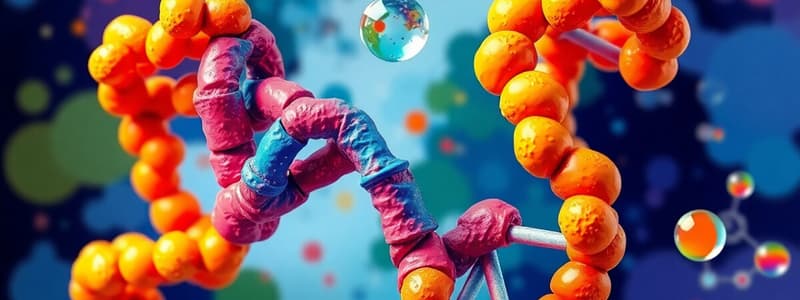Podcast
Questions and Answers
What stabilizes the secondary structure of proteins like alpha helices and beta sheets?
What stabilizes the secondary structure of proteins like alpha helices and beta sheets?
- Hydrogen bonds among atoms of the backbone (correct)
- Hydrophobic interactions between nonpolar side chains
- Disulfide bridges between cysteine residues
- Ionic bonds between side chains
Which level of protein structure is primarily responsible for the three-dimensional shape of a protein?
Which level of protein structure is primarily responsible for the three-dimensional shape of a protein?
- Primary structure
- Quaternary structure
- Secondary structure
- Tertiary structure (correct)
What types of bonds contribute to the quaternary structure of a protein?
What types of bonds contribute to the quaternary structure of a protein?
- Peptide bonds between amino acids
- Hydrophobic interactions exclusively
- All types of bonds and interactions among the side chains (correct)
- Covalent bonds only
What role do chaperone proteins play in the folding of other proteins?
What role do chaperone proteins play in the folding of other proteins?
Which of the following interactions is NOT involved in maintaining protein tertiary structure?
Which of the following interactions is NOT involved in maintaining protein tertiary structure?
If the primary structure of a protein is altered, what is the most likely consequence?
If the primary structure of a protein is altered, what is the most likely consequence?
What type of secondary structure is characterized by a spiral shape?
What type of secondary structure is characterized by a spiral shape?
Which interactions primarily stabilize beta sheets in protein structures?
Which interactions primarily stabilize beta sheets in protein structures?
What type of reaction involves the formation of polymers from monomers by removing water?
What type of reaction involves the formation of polymers from monomers by removing water?
Which of the following would indicate that a side chain is polar charged?
Which of the following would indicate that a side chain is polar charged?
What maintains the primary structure of a protein?
What maintains the primary structure of a protein?
Which statement correctly describes hydrolysis reactions?
Which statement correctly describes hydrolysis reactions?
In an amino acid structure, which component determines the specific characteristics of that amino acid?
In an amino acid structure, which component determines the specific characteristics of that amino acid?
Which bonds are crucial for forming secondary protein structure?
Which bonds are crucial for forming secondary protein structure?
What is the typical outcome of condensation reactions in terms of energy and product?
What is the typical outcome of condensation reactions in terms of energy and product?
What type of bond would primarily be involved in the stabilization of tertiary protein structure?
What type of bond would primarily be involved in the stabilization of tertiary protein structure?
What is the primary role of an enzyme's active site?
What is the primary role of an enzyme's active site?
Which of the following statements accurately describes competitive inhibition?
Which of the following statements accurately describes competitive inhibition?
Which of the following is an example of a non-functional enzyme affecting a cell?
Which of the following is an example of a non-functional enzyme affecting a cell?
How do cofactors differ from coenzymes in enzyme function?
How do cofactors differ from coenzymes in enzyme function?
What effect does allosteric inhibition have on enzyme activity?
What effect does allosteric inhibition have on enzyme activity?
What happens to protein function if the primary structure of the protein is altered?
What happens to protein function if the primary structure of the protein is altered?
Which of the following correctly defines Gibb's free energy?
Which of the following correctly defines Gibb's free energy?
What characterizes exergonic reactions in terms of Gibb's free energy?
What characterizes exergonic reactions in terms of Gibb's free energy?
Which pair represents a characteristic of anabolic reactions?
Which pair represents a characteristic of anabolic reactions?
How do endergonic reactions relate to Gibb's free energy?
How do endergonic reactions relate to Gibb's free energy?
What is the role of an active site on an enzyme?
What is the role of an active site on an enzyme?
Which statement correctly contrasts catabolic and anabolic reactions?
Which statement correctly contrasts catabolic and anabolic reactions?
When comparing condensation and hydrolysis reactions, which statement is accurate?
When comparing condensation and hydrolysis reactions, which statement is accurate?
Flashcards are hidden until you start studying
Study Notes
Protein Structure
- The basic structure of an amino acid includes a central carbon, carboxyl group, amino group, and a side chain.
- The side chains can be nonpolar, polar uncharged, or polar charged depending on their chemical properties.
- Proteins form through condensation reactions that remove water, linking monomers (amino acids) to form polymers.
- Hydrolysis reactions break down polymers into monomers using water.
- The primary structure of a protein is determined by the sequence of amino acids linked by peptide bonds between the carboxyl group of one amino acid and the amino group of the next.
- Secondary structure refers to local folding patterns stabilized by hydrogen bonds between backbone atoms. The two common types are alpha helices and beta pleated sheets.
- Tertiary structure describes the three-dimensional shape of a protein, influenced by interactions between side chains of amino acids. These interactions include hydrogen bonds, ionic bonds, hydrophobic interactions, and disulfide bridges.
- Quaternary structure arises when multiple polypeptide chains (subunits) associate together, creating a complex protein with a defined arrangement.
- Chaperone proteins assist in proper protein folding, particularly within the endoplasmic reticulum (ER).
Energy & Enzymes
- Energy is stored in chemical bonds, and free energy (G) represents the energy available to do work within a system.
- Changes in free energy during a reaction can be represented graphically, with the difference in free energy between reactants and products indicating if the reaction is endergonic (requires energy) or exergonic (releases energy).
- Endergonic reactions are anabolic, meaning they build larger molecules and require energy input.
- Exergonic reactions are catabolic, breaking down larger molecules and releasing energy.
- Activation energy is the energy required to start a reaction, and the transition state is the unstable intermediate state during the reaction.
- Enzymes act as biological catalysts, speeding up reactions by lowering activation energy without affecting the overall free energy change.
- Enzymes have active sites where substrates bind, facilitating the formation of a transition state and promoting the reaction.
- Enzyme activity can be regulated by allosteric inhibition (binding to a site other than the active site) and competitive inhibition (competing with the substrate for the active site).
- Negative feedback inhibition occurs when the product of a reaction inhibits the enzyme involved in its production, regulating the pathway.
- Enzyme shape changes can affect function. Mutations affecting primary structure or regulatory mechanisms like allosteric interactions can disrupt enzyme activity.
- Nonfunctional enzymes can have significant consequences for a cell, as they may disrupt metabolic pathways, leading to disease or dysfunction.
- Cofactors and coenzymes can assist enzymes in function. Cofactors are inorganic ions, while coenzymes are organic nonprotein molecules.
Studying That Suits You
Use AI to generate personalized quizzes and flashcards to suit your learning preferences.




